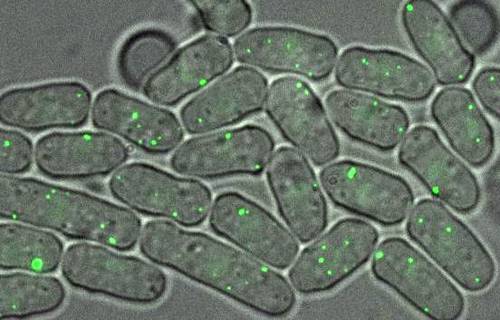
Protein aggregates tagged with green fluorescent protein (Hsp104-GFP).
When yeast cells divide they not only pass on a copy of their genome and the organelles needed for the next generation, but often a lifetime’s worth of waste proteins. Certain strains of yeast adjust their transfer of waste protein to offspring in response to stress but until now the exact mechanism behind this switching was unknown. This week in PLOS Biology, Max Planck researchers provide a simple explanation based on the snowball-like fusion of small proteins into large clumps within the cell.
We all pass unwanted stuff on to our children – furniture, jewellery and those old Rolling Stones T-shirts we all know are never going to be worn. Luckily, we have access to eBay, but what happens when the hand-me-downs are not forgotten trinkets, but major parts of our cells?
In species of yeasts that reproduce asymmetrically, such as baker’s yeast (Saccharomyces cerevisiae), mother cells take on the burden of their own damaged proteins, separating them out in order to produce a daughter that is clear of the harmful aggregates. Symmetrically reproducing species (Schizosaccharomyces pombe) on the other hand tend to act more selfishly, halving their own aggregates with their daughters. However, under periods of stress (such as high temperatures) symmetrically reproducing mother cells switch to asymmetric reproduction, in order to prevent passing on potentially harmful levels of aggregates.
What is the mechanism behind this switching and how is it regulated under times of additional stress? Iva Tolić-Nørrelykke and colleagues set about answering these questions in their new paper published in PLOS Biology.
By tagging the protein aggregates with a fluorescent protein (Hsp104-GFP), the team found that aggregated proteins diffuse around the cell freely; where upon they bump into others and snowball into larger clumps of protein. The separation of the proteins into the symmetrically or asymmetrically splitting daughter cells is then based on whether the cells divide off-centre and their relative cell volume. High levels of stress increase the overall amount of protein aggregates as well as their fusion rate. After one or two generations of cell division the clumps form a protein aggregate so large that it has to remain with a single cell during subsequent replication, explaining the switch to asymmetrical reproduction. The team also identified the key protein responsible for the fusion process: Hsp16. Lastly, the authors produced a mathematical model confirming that after stress, the increased amount of protein aggregates fuse into one, which is asymmetrically passed on to a single offspring cell.
This simple explanation provides fundamental insights into a general mechanism for asymmetrical segregation of cellular factors at division.
Miguel Coelho, Steven J. Lade, Simon Alberti, Thilo Gross, Iva M. Tolic:
Fusion of Protein Aggregates Facilitates Asymmetric Damage Segregation
PLOS Biology, 17 June 2014
doi: 10.1371/journal.pbio.1001886